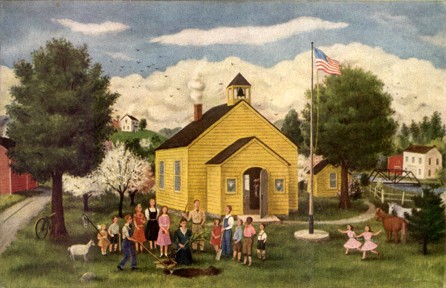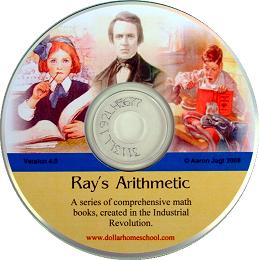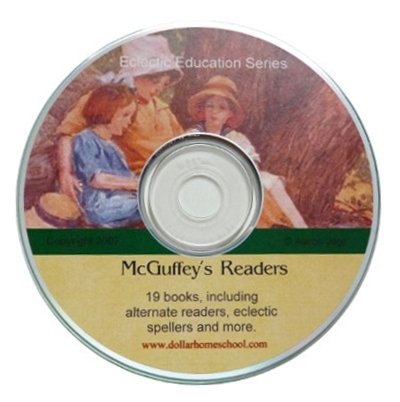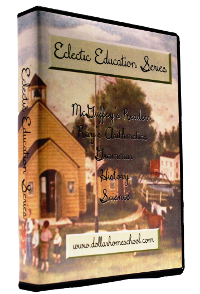I am always looking for better ways to help my readers discover the simple, wonderful world of 19th century learning. I have recommended all sorts of resources, from the high-end, hard-bound sets of reprints in these blessed materials, to downloading free eBooks from Internet Archive and Google Books.
I love all types—I have three sets of hard-bound McGuffey's Readers,Harvey
Recently I received a number of CD’s containing what was entitled "The Eclectic Learning Series" published from the 1830's to the early 20th century in the mail from Dollar Homeschool. I was curious as to how user-friendly and useful these collected works would be for myself and others, so Aaron Jagt sent me a copy of the set so that I could review them.
Aaron has done a great job of putting a pretty comprehensive compilation of these old tomes together. I was pleasantly surprised to find much more was included than is listed on his website. Each disk was like opening a present at Christmas!
For instance, I wasn’t expecting to find sound recordings of lectures on the godly nature of mathematics. I can imagine hours sitting and listening to these while the children are sketching or doodling on a hot summer’s afternoon.
Also included is a series of books which attempt to teach grammar and composition through literature, using both copy work and dictation. I had just been researching such an approach among the free books online, so it was such a relief to find that one had already been included!
There is enough material in the history section for copy work, narration, timelines, etc. to last many years—including poetry.
I have become an enthusiast of 19th century learning materials because they were formulated and used during a time our society was greatly influenced by Biblical Christianity. Professor McGuffey himself was a Presbyterian minister. Also, to a great extent, these materials were created before many of the most radical “reforms” of Horace Mann and John Dewey were accepted "at-large" and implemented (although their eroding influence is evident even in the revised McGuffey readers of the 1880’s).
I get excited when we use these materials because of the clarity of thought, and the respect paid to the learner. No dumbed-down content here—economy was a necessity of the past, when paper and ink were precious, especially in the frontier schools. Each word, each number problem, was well-thought out and meaningful. The curricula of the age were free of “busy work”, making them just perfect for application in homeschools and tutoring programs where consistent, concentrated instruction is the preferred method.
I know many of these books are available for free online, but I also know the sites on which they are offered are not always reliable, and I have recently found it difficult to find many of the titles necessary for a well-rounded Eclectic Series education (discovering the entire set of revised McGuffey’s editions can be like chasing a snake through the grass). It can also be confusing with all of the different versions of each of the Ray’s Arithmetics, for instance. I could see spending a bit of money in order to own this compilation for the duration of my children’s homeschooling educational years.
 |
| A day at a frontier school. |
I love all types—I have three sets of hard-bound McGuffey's Readers,
Recently I received a number of CD’s containing what was entitled "The Eclectic Learning Series" published from the 1830's to the early 20th century in the mail from Dollar Homeschool. I was curious as to how user-friendly and useful these collected works would be for myself and others, so Aaron Jagt sent me a copy of the set so that I could review them.
Aaron has done a great job of putting a pretty comprehensive compilation of these old tomes together. I was pleasantly surprised to find much more was included than is listed on his website. Each disk was like opening a present at Christmas!
For instance, I wasn’t expecting to find sound recordings of lectures on the godly nature of mathematics. I can imagine hours sitting and listening to these while the children are sketching or doodling on a hot summer’s afternoon.
Also included is a series of books which attempt to teach grammar and composition through literature, using both copy work and dictation. I had just been researching such an approach among the free books online, so it was such a relief to find that one had already been included!
There is enough material in the history section for copy work, narration, timelines, etc. to last many years—including poetry.
I have become an enthusiast of 19th century learning materials because they were formulated and used during a time our society was greatly influenced by Biblical Christianity. Professor McGuffey himself was a Presbyterian minister. Also, to a great extent, these materials were created before many of the most radical “reforms” of Horace Mann and John Dewey were accepted "at-large" and implemented (although their eroding influence is evident even in the revised McGuffey readers of the 1880’s).
I get excited when we use these materials because of the clarity of thought, and the respect paid to the learner. No dumbed-down content here—economy was a necessity of the past, when paper and ink were precious, especially in the frontier schools. Each word, each number problem, was well-thought out and meaningful. The curricula of the age were free of “busy work”, making them just perfect for application in homeschools and tutoring programs where consistent, concentrated instruction is the preferred method.
I know many of these books are available for free online, but I also know the sites on which they are offered are not always reliable, and I have recently found it difficult to find many of the titles necessary for a well-rounded Eclectic Series education (discovering the entire set of revised McGuffey’s editions can be like chasing a snake through the grass). It can also be confusing with all of the different versions of each of the Ray’s Arithmetics, for instance. I could see spending a bit of money in order to own this compilation for the duration of my children’s homeschooling educational years.

I did some figuring to help show the actual costs of these materials. I found there were 109 books total included in this package (if I have not missed any). This does not include the audio CD. If the asking price is $160, this makes the books cost approximately $1.47 each!
Of course, these are “digital” books—not easy to take to one’s room and study, unless you happen to have a number of computers for each child or a few of those nifty “reader” devices or an iPad. These devices would make the use of these excellent "digital" books much more “portable”.
For myself, I prefer to have the “tangible” form of books. I like turning pages and making places for more books on my library shelves. This is why I am planning on printing and binding a number of these books.
I figure that, on my little ink-jet, I should get about (700-800) pages per cartridge, that is using the “economical, black-only” setting. If I select "two-to-a-page" printing, this means I should be able to print about 15, 90-page books or seven to eight, 150-page books per cartridge (at $26 per cartridge). This makes it approximately $1.73 - 3.46 per book (or twice that for a three-hundred page book).
The paper is not very expensive, since I purchase it in ten-ream boxes from either Sam’s Club (free shipping) or a local office supply store where it was on sale (I noticed a ten-ream box on sale at Office Depot for about $25). This keeps my paper for a 90-page book (with the “two-pages-to-a-sheet” mode selected) at about $0.27!
Dollar Homeschool’s agreement states a person can print up to four copies of each book for personal use, which is plenty.
So here’s the breakdown in current prices for binding a 150-page book, using the “economy” and “Two-pages-per-sheet” settings:
$1.47—average cost of digital book
$3.46—ink
$0.54—paper
$2.00—comb-binding
$0.50—miscellaneous expenses
$7.97 per book! (or $0.03 - 0.05 per page)
This is such a frugal way to go, even if one has to put in a little “sweat-equity” in binding the books, especially when compared to other curriculum options. Even finding these materials is challenging.
These books are non-consumable, so they can be passed down from child-to-child, making this a one-time purchase for many years’ worth of learning.
I went on line and compared the costs of a popular mathematics curriculum to what’s included here—an entire elementary course in mathematics would cost upwards of $600—and then there would be the expense of replenishing some of the consumable workbooks required for the course.
Printing the books included on the Ray’s Arithmetics Dollar Homeschool CD, that is all 39 of them, would equal about $348 (and you probably wouldn’t want nor need to print out all 39).
Printing and binding all of the basic McGuffey readers, at the $0.03 - 0.05 per page rate, would cost approximately $51.94 - $84.30.
For our little homeschool group, I am considering purchasing my own manual comb-binding apparatus. I am looking seriously at the Fellowes Star for about $55 on this site. It would make sense for us, since I love binding up books and booklets and should make it worth the initial investment in little or no time!
My oldest daughter is looking into the “click and print” option which is being offered by a number of printing houses. I will try and post her findings at a later date.
I am also considering printing up “booklets” of assigned material printed from the digitized books and catered to each child, which might include some note booking pages. In my thought processes are some extra practice booklets compiled from the White's and Dubb's math books. It would also be fun to create note booking pages for the Nature Study book.
It must be obvious that these materials would have to be supplemented with more up-to-date publications as well. A good set of encyclopedias and the Internet are a good start, and a library card would be a frugal way to round-out and complete a good education with these "digital" books as the foundation. Still, for the cost of just one year’s curriculum for one child, it is nice to own materials enough for many years (for example, Rod and Staff complete 1st grade, reading and math, costs $132)!
In case you feel as lost as I did when I began my homeschooling journey, Dollar Homeschool offers a Yahoo discussion forum with a number of archived discussions which helped me enormously when I began this review.
I do wish that the Manual of Methods was included on the McGuffey’s CD, as it really helps to clarify the use of these books in teaching reading—even takes one through the different methods in a more succinct way than I have ever read it expressed. I’m going to suggest this to Aaron Jagt so this may be changed in the near future.
If you are like me, prone to “creative meanderings”, then these materials are for you. Using these books allows me to enjoy my creative side, while giving me a basic structure that is sound and Biblically-based, free of a lot of the nonsense found in so many of the expensive alternatives of our present day.
For our little homeschool group, I am considering purchasing my own manual comb-binding apparatus. I am looking seriously at the Fellowes Star for about $55 on this site. It would make sense for us, since I love binding up books and booklets and should make it worth the initial investment in little or no time!
My oldest daughter is looking into the “click and print” option which is being offered by a number of printing houses. I will try and post her findings at a later date.
I am also considering printing up “booklets” of assigned material printed from the digitized books and catered to each child, which might include some note booking pages. In my thought processes are some extra practice booklets compiled from the White's and Dubb's math books. It would also be fun to create note booking pages for the Nature Study book.
It must be obvious that these materials would have to be supplemented with more up-to-date publications as well. A good set of encyclopedias and the Internet are a good start, and a library card would be a frugal way to round-out and complete a good education with these "digital" books as the foundation. Still, for the cost of just one year’s curriculum for one child, it is nice to own materials enough for many years (for example, Rod and Staff complete 1st grade, reading and math, costs $132)!
In case you feel as lost as I did when I began my homeschooling journey, Dollar Homeschool offers a Yahoo discussion forum with a number of archived discussions which helped me enormously when I began this review.
I do wish that the Manual of Methods was included on the McGuffey’s CD, as it really helps to clarify the use of these books in teaching reading—even takes one through the different methods in a more succinct way than I have ever read it expressed. I’m going to suggest this to Aaron Jagt so this may be changed in the near future.
If you are like me, prone to “creative meanderings”, then these materials are for you. Using these books allows me to enjoy my creative side, while giving me a basic structure that is sound and Biblically-based, free of a lot of the nonsense found in so many of the expensive alternatives of our present day.
My Ray's Arithmetics and McGuffey's Primer Helps go perfectly with this set for teaching basic math and beginning phonics and reading!
































I feel so lost looking at these, trying to figure out what to use. Are the mcguffeys readers included on these disks the original or revised version? and what are the alternate readers? If these are the revised version, can you give me a link to where I might find the originals?
ReplyDeleteI know you gave a post earlier about the revised and originals, but I still can't figure out, in simple terms, what the difference is between the two. Are they completely different sets of stories? Edited stories?
It's all making me feel rather inadequate! I am struggling to wrap my head around how these things work with my public-schooled mind. I have read all your posts and I'm still somewhat lost.
I am new to your blog and am really enjoying reading it!
ReplyDeleteGina
I agree, Ray's Arithmetic is so difficult to find online! I spent quite a bit of time trying to match up all the correct editions without success. It's much easier to get it all on CD.
ReplyDelete